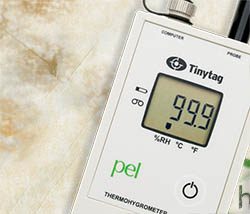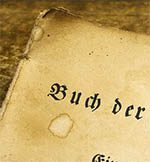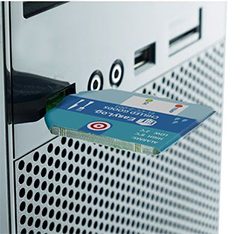It's all relative, humidity...
Last month we wrote about the importance of managing light to prevent damage to collections – we’re completing the story with a few tips on managing humidity and temperature. I was actually prompted by a visit to a museum where a logger in one of the display cases was showing RH of over 67%. This seemed pretty high to me, especially on what was a fairly hot and dry day, so what should they be doing to manage it?
I was actually prompted by a visit to a museum where a logger in one of the display cases was showing RH of over 67%. This seemed pretty high to me, especially on what was a fairly hot and dry day, so what should they be doing to manage it?
Firstly, what’s RH?
RH (relative humidity) is presented as a percentage, it’s not a straight measure of how much water is in the air. Air is capable of carrying higher levels of water the warmer it gets, conversely cooler air can carry less moisture. The percentage displayed by a RH meter is actually a percentage of the maximum saturation of the air at the current temperature. So there will be more water vapour at 60% RH when the temperature is 25°C than there would be at 15°C.
And what’s dew point?
If air is cooled, whilst the moisture content is kept constant (i.e. in a sealed display case), to the point where the RH reaches 100%, the water vapour will condense. This is the dew point. Further reductions in temperature will lead to further water condensing out as the air keeps its saturation point at 100%. Imagine when the heating goes off/on, sun goes down, sudden changes in temperature can push RH up and down drastically.
What are the consequences of failing to manage relative humidity?
Generally it is accepted that an RH of between 40% and 60-65% is suitable for a museum environment. Here are some of the ways that objects can be effected by:
- Unstable RH (Fluctuations over +/-3% within a 24hr period)
An unstable level of humidity can lead to hygroscopic materials to swell (in high humidity) and contract (in low humidity). This swelling and contraction of the material causes stress on the connecting fibres, gradually weakening them causing embrittlement, flaking oil paintings are a good example of expansion and then subsequent contraction. Some materials may show some efflourescence of salts as they crystallise after being dissolved. Fluctuations shouldn’t be more than +/- 3% relative humidity within a 24 hour period.

As well as allowing hygroscopic materials to swell, high RH can also lead to mould or fungal growth at levels over 70%, and encourage pests. Emulsions on photographs can adhere to sleeves or other photographs. Metals can rust as a result of high moisture content. High moisture levels are also linked with the ‘crisseling’ of glass, producing small cracks in the surface which appear to haze the finish.
Low RH causes materials to dry out and contract. Glues and repairs may dry out become brittle and break, this includes veneers on wooden objects which may lift.
It becomes clear that stability is an important factor in RH management and provided the environment is in the accepted 40%-60% range, your collection should be safe.
How can you manage RH?
First, you need to carefully consider the appropriate level of relative humidity that your objects will require. Museums and Galleries Scotland have a good guide for specific exhibit requirements which are detailed on
this page.
Sudden changes are not desirable, so it’s always best to monitor and determine the existing conditions and what measures you can take generally to improve levels, such as closing doors and windows, and additional ventilation or heating.
 Monitor humidity levels
Monitor humidity levels There are various methods of measuring relative humidity, from basic humidity cards, through to hygrometers and datalogger devices which offer higher levels of accuracy.
- Humidity Cards - A basic visual relative humidity scale that can be inexpensively added to display cases and storage areas. Accurate to 10%+/-.
- Hygrometers - For more accurate measurement of relative humidity a (calibrated) digital hygrometer is by far the best way to go. For combined measurement of temperature, a thermohygrometer will also give you a temperature reading. Hygrometers are relatively inexpensive, our cheapest digital thermohygrometer is only £16, they become more expensive in-line with their accuracy and range, as well as overall build quality – we recommend our museum specification unit here.
- Data Loggers - With a combined data logging thermohygrometer you are able to take a long term view of the environment, our loggers can record up to a year’s worth of data. Data loggers are useful for data analysis negating the need for manual data entry, especially useful where there are numerous locations being monitored and compared.
Technology in the datalogger field moves apace. Some of our new data loggers, like this one, can be remotely accessed on the EasyLog Cloud from any internet enabled device, including an App for smartphones and tablets, allowing instant and real-time monitoring of conditions. Immediate notifications of alarm breaches can be sent to one or multiple emails with escalating alarm modes if required.
The Easylog slimline compact datalogger is smaller than a credit card and amazingly only around 5mm thick. Data is retreived from the unit using the integral USB connector and free software - it's ideal for logging data during transportation,  where the recipient can simply retreive the data, or send the logger back in the post. Its compact dimensions allow placement in areas that other dataloggers cannot be placed, for instance, behind a picture frame, or discretely in a display. More information on the datalogger can be viewed here
where the recipient can simply retreive the data, or send the logger back in the post. Its compact dimensions allow placement in areas that other dataloggers cannot be placed, for instance, behind a picture frame, or discretely in a display. More information on the datalogger can be viewed here
Manage humidity levels
- Dessicants, such as Prosorb cassettes or PELsorb silica gel are pre-conditioned to achieve the level of humidity you require (at 20°C). They are ideal for smaller sealed areas such as display cases. The dessicants both absorb and desorb moisture helping maintain the correct humidity level. It’s important to remember that the storage environment may already have a ‘buffer’ if it is made from MDF or wood. These materials can make micro-climate management more difficult as they will also absorb and desorb moisture.
- Dehumidifiers can be used in larger open areas and storage facilities, if in a room without drainage it’s important to consider how you will manage the recovered water. Some units, such as this one, are capable of pumping it away, even up to a height of 4.3 meters. Otherwise they will have a storage vessel that once full will stop the dehumidifier from running, this may not be ideal should the unit be left to run unattended.
Temperature
So we know the relationship between temperature and relative humidity, however, does that mean that we can simply concentrate on that RH figure and ignore the temp? Err. No. But managing a stable temperature will make the management of RH levels far easier.
The ideal temperature for preservation of archival documents is between 16°C -19°C. Increases in temperature can also have an adverse effect on collections. It is estimated that for every 10°C increase in temperature, chemical reactions in paper double. Heat also causes expansion and contraction which, regardless of relative humidity level, can lead to damage to collections.
Use of a thermohygrometer will help you to manage both temperature and relative humidity in a single meter. Again, as with relative humidity, consistency is key and maintaning a stable temperature is important.
Everywhere you go, take the weather with you. One thing that you cannot currently log with a datalogger is the weather, however correlation with external environments is also helpful when analysing datasets. Consider using a third party metereological source to add context to reports.
The blog has more stuff - Read the 'one' about light here.